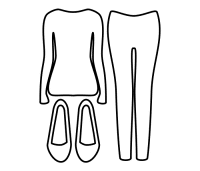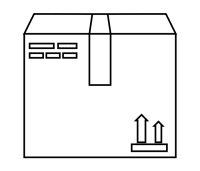Sonigo takes great pride in its teams of professional packers. Our professionally trained packers use the latest materials and methods to ensure your goods arrive at their final destination in good condition. We guarantee you will enjoy their professionalism.
Proper packing and loading are the two most critical steps that your move entails. The law is simple: well packed and loaded items arrive safely. We have composed this “packing tips” manual for you benefit. Use it well!
Make an itemized list of what is going into each box that you pack. This will help both in clearing customs, as well as determining insured value. Please remember that boxes you pack have limited liability on insurance. Also, please check with your Sonigo sales representative to determine if self-packing will save any money (it often does not…) and to review limitations in coverage.
Start with out-of-season items. Next, pack things used infrequently. Leave until last the things you’ll need until moving day.
Empty drawers of breakables, spillables, and items not recommended for inclusion in your shipment, as well as anything that would puncture or damage other items. However, blankets, sweaters, lingerie, bath towels and similar soft, lightweight goods may be left in drawers.
Pack similar items together. For example, do not pack a delicate china figurine in the same carton with cast-iron frying pans.
Keep all parts or pairs of things together. For example, curtain rod hangers, mirror bolts and other small hardware items should be placed in plastic or cloth bags (which can be purchased from the moving company) and taped or tied securely to the article to which they belong.
Wind electrical cords and fasten them so that they do not dangle.
Wrap items individually in clean paper; use tissue paper, paper towels or even facial tissue, fine china, crystal and delicate items. Colored wrapping draws attention to very small things. Use a double layer of newspaper for a good outer wrapping.
Place a two- or three-inch layer of crushed paper in the bottom of a carton for cushioning.
Build up in layers, with heaviest things on the bottom, medium weight next and lightest on top.
As each layer is completed, fill in empty spaces firmly with crushed paper and add more crushed paper to make a level base for the next layer, or use sheets or cardboard cut from cartons as dividers.
Cushion well with crushed paper; towels and lightweight blankets also may be used for padding and cushioning. The more fragile the item, the more cushioning needed. Be sure no sharp points, edges or rims are left uncovered.
Pack small, fragile, individually wrapped items separately or a few together in small boxes, cushioning with crushed or shredded paper.
Place small boxes in a single large box, filling in spaces with crushed paper.
Avoid overloading cartons, but strive for a firm pack that will prevent items from shifting the cover. The cover should close easily without force, but should not bend inward.
Seal cartons tightly with tape, except for those containing items listed on United’s High-Value Inventory form. These must be left open for the van operator’s inspection.
As you finish with each carton, list the contents on the side of the carton (for easy viewing while cartons are stacked) and in a special notebook. You might want to number and/or code the cartons as well.
Indicate your name and the room to which each carton should be delivered at destination. Tape a sign on the door of each room at destination corresponding to the carton labels so movers can get the cartons into the proper rooms quickly.
Put a special mark on cartons you want to unpack first at destination.

Moving company packers use a dish pack – an exceptionally sturdy corrugated carton of double – wall construction for china, glassware and other fragile items less than 18 inches in size. Unless cartons of similar strength and construction are valuable, you might want to purchase several dish packs from the moving company.
Wrap all pieces of china and glassware individually in clean paper. Using several sheets of paper, start from the corner, wrapping diagonally and continuously tucking in overlapping edges. A double layer of newspaper serves well as an outer wrapping. A generous amount of paper padding and cushioning is required for all china and glassware. Label cartons, “FRAGILE — THIS SIDE UP.”

Larger china and glass plates, platters and other flat pieces are excellent as the lowest layer in a dish pack. Place cushioning material in the bottom of a carton. Wrap each piece individually, and then wrap up to three in a bundle with a double layer of newspaper. Place these bundled items in the carton in a row on edge.
Surround each bundle with crushed paper, being careful to leave no unfilled spaces. Add two or three inches of crushed paper on top of the bundle to protect rims and make a level base for the next tier. Horizontal cardboard dividers can be helpful in keeping layers level.
Smaller plates, saucers and shallow bowls can make up a second layer. Wrap and pack in the same way as larger items.

Depending on their weight, these might be used either as the bottom or middle layers. Wrap the same way as flat plates. Stand shallow bowls (soup plates, etc.) on edge in the carton and deep ones (such as mixing bowls) nested two or three together, upside down on their rims.
Wrap sugar bowl lids in tissue, turning them upside down on top of the bowl. Then, wrap both together in clean paper, followed by an outer double layer of newspaper. Wrap cream pitchers in clean paper and then a double outer wrapping. Place sugar bowls, cream pitchers, sauce containers and similar pieces upright in the carton.

Even when using a dish pack and mini-cells for china, wrap cups individually, protecting handles with an extra layer of paper. Then pack cups upside down.
If not using a dish pack or cells, wrap cups as previously described in a double layer of paper and place them upside down on rims in a row on an upper layer with all handles facing the same direction.

Because air causes silver to tarnish, all silver pieces should be enclosed completely in clean tissue paper or plastic wrap. Holloware — including bowls, tea sets and serving dishes — should be wrapped carefully as fragile items and packed like china.
Loose flatware may be wrapped either individually or in sets, and in clear plastic or tissue. If silverware is in a chest, you still might want to wrap the pieces individually and reposition them in the chest. Another option is to fill in all empty spaces in the chest with tissue paper or paper towels. Wrap the chest with a large bath towel.

Many moving companies use a material called bubble pack (plastic with bubbles) for exceptionally fragile items. If an item is extremely valuable as well as delicate, it might be wise to have it packed for you. Special materials might be needed for maximum protection.

Wrap first it tissue paper, paper towels or facial tissue. Then, wrap carefully in newsprint that has been crushed and flattened out. Be sure the items are well-protected with plenty of cushioning. Small mirrors, plaques and pictures should be wrapped individually in tissue paper. A bath towel or small blanket makes an excellent outer wrapping and padding for glass. Place items on edge in a carton.

An arrangement of artificial flowers should be packed in its own carton. Wrap carefully in plastic wrap, tissue paper or paper towels. If possible, fasten the base of the floral piece to the bottom of the carton. Label the carton “FRAGILE — THIS SIDE UP.” For instructions on moving live plants, ask your agent for a “Moving with House Plants” brochure.

After removing the light bulb and lamp harp, wrap the base, harp and bulb separately innewsprint. (Use paper pads for large lamps.) Place them together in a carton, filling spaces with crushed paper. More than one well-cushioned lamp may be packed in a carton.

All are easily damaged. Glass might shatter and marble slabs can crack at veins. Paper never should be permitted to touch the surface of an oil painting. It’s best to consult with your moving company about custom-made cartons and crates for items of this kind.

Pack them either flat or with the spine touching the bottom of the carton. Do not pack with spine facing up, as glue can break away from the binder. Pack books of the same general size together. Expensively bound volumes or those of special sentimental value should be individually wrapped before packing. Because books are heavy, be sure to use small cartons.

Remove these items from the stereo or storage cabinet. Keep in mind that records are heavy and should be packed in small cartons. If records are not in jackets, wrap individually in tissue paper or plastic wrap to protect them from being scratched. Stand compact discs and records on edge, never flat, on a layer of crushed paper. Support at both ends with a large, hardcover book or several pieces of cardboard cut to fit. Top with another layer of crushed paper. Identify contents on the outside of the box and mark “FRAGILE.”

Clothing left on hangers and placed in wardrobe cartons used by moving companies will arrive at destination wrinkle-free. You might want to purchase several of these special cartons from your moving company. One will hold about two feet of compressed clothing on hangers.
If wardrobe cartons are not used, each garment should be removed from its hanger, folded and placed in a suitcase or a carton lined with clean paper. Some lightweight clothing — such as lingerie and sweaters — may be left in bureau drawers.
Hats may be left in hatboxes and placed in a large carton. Or, stuff the crown of each hat with crumpled tissue paper; wrap tissue loosely around the outside and place in a carton lined with clean paper, with the heavier hats on the bottom. Don’t pack anything else with hats. Label the carton “FRAGILE.”
Footwear may be left in shoeboxes and placed in a large carton. Another option is to wrap each shoe individually and then in pairs. Footwear should be cushioned to avoid damage to heels or ornaments. Don’t pack heavy items on top of shoes. It is recommended that you take your furs with you rather than having them moved on the van.

Blankets, sheets, tablecloths, towels, pillowcases and other linens may be protected by a large plastic bag and packed in a carton that has been lined with clean paper. Wrap your most prized linens in tissue. Also, linens and bedding are good for cushioning or padding many types of items. Special mattress cartons in various sizes are available from your moving company for a nominal charge. Pillows may be placed in bureau drawers or packed in cartons.

Clothing wardrobes are ideal for moving curtains and draperies. Fold them lengthwise, place over a padded hanger, pin securely and hang in the wardrobe. Draperies and curtains also may be folded and packed in cartons lined with clean paper or plastic wrap.

Leave rugs on the floor for the moving company to handle. If they’ve just been returned fromthe cleaners, leave them rolled.

Pre-move preparation is required for many major appliances. Set an appointment with a service technician to prepare your major appliances for shipment – or have your agent send someone out who is authorized to perform this service.

Items such as clocks, small radios and other small appliances should be wrapped individually and packed in a carton cushioned with crushed paper.
Small clocks, transistor radios and similar items can be packed in the same carton with linens or as extra items with lamp bases. Make sure cords are wrapped so as not to scratch or otherwise damage items. Steam irons should be emptied of all water, wrapped and placed in the cushioned bottom of a box. Remove all batteries from small appliances before packing.

Long-handled garden tools, as well as brooms and mops, should be bundled together securely. Attachments should be removed from power tools and packed separately.
Hand tools may be left in tool boxes and the spaces filled with crushed paper, or may be packed according to general packing rules. Always use small cartons because tools usually are heavy.

Before moving day, dismantle children’s swing sets, TV antennas and garden sheds. Gather pieces and bundle together with nylon cord. Place small hardware in a cloth bag and securely attach to corresponding equipment. Prepare lawn mower by draining gasoline prior to the day of loading.

Take only food items you are sure will travel well.
Do not take anything perishable.
In the winter months, do not take anything subject to freezing. Open boxes of dried or powdered foods such as rice, macaroni and cereals should be sealed with tape.
Small containers of herbs and spices, condiments, bouillon cubes, gelatin, flavorings, etc. should be placed together in a small box before packing in a large carton.
Cover holes of shaker-type containers and seal with tape.
Since canned goods are heavy, the amount placed in one carton should be limited.

The popularity of home electronic items has added a new dimension for the do-it-yourself packer. Home computers, microwave ovens and stereo systems require special care to ensure they arrive at destination safely.
If you saved the original cartons and packing materials in which these items arrived, it is best to repack using those materials. Should you not have these materials, you might want to contact a store selling your particular item and ask if discarded packing materials are available.
Your Sonigo representative and all of our agents are familiar with current techniques for properly packing electronic items and can assist you with advice or pack the items for you. It is your responsibility to disconnect electronic items prior to packers’ arrival.
We are here to help you!
6 BNEI DAROM, INDUSTRIAL AREA PO BOX 7409, GAN YAVNE 7080000, ISRAEL
972 8 6111-223
FACTORS THAT CONTRIBUTES TO OUR
SUCCESS
We go above and beyond for our clients. We don’t move any other way




Want to get a price estimate without obligation?